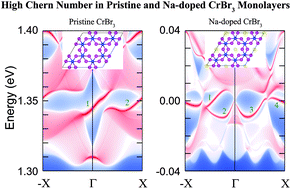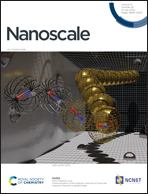High-temperature and multichannel quantum anomalous Hall effect in pristine and alkali–metal-doped CrBr3 monolayers†
Abstract
The realization of the high-temperature and multichannel quantum anomalous Hall effect (QAHE) has been a central research area in the development of low-power-consumption electronics and quantum computing. Recently discovered two-dimensional (2D) ferromagnetic (FM) materials provide unprecedented opportunities for the exploration of the high-temperature QAHE. Based on first-principles approaches, we first reveal that a FM CrBr3 monolayer harbors topologically nontrivial conduction bands with a high Chern number of C = 2. Then, we reveal that the interesting conduction bands can be moved downwards to the Fermi levels by electron and alkali–metal-doping; meanwhile, the QAHE characteristics can be preserved. Most strikingly, the Na-doped CrBr3 system possesses a higher Chern number of C = −4 with a transition temperature of ∼54 K, which is attributed to the constructive coupling effect of the quadratic non-Dirac and linear Dirac band dispersions. The present study, together with recent achievements in the field of 2D FM materials, provides an experimentally achievable guide for realizing the high-temperature and multichannel QAHE based purely on 2D FM systems.

- This article is part of the themed collection: 2020 Nanoscale HOT Article Collection


 Please wait while we load your content...
Please wait while we load your content...